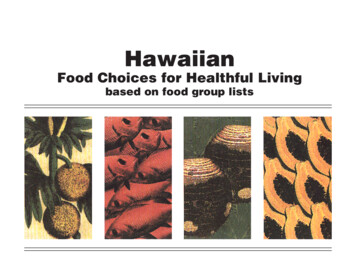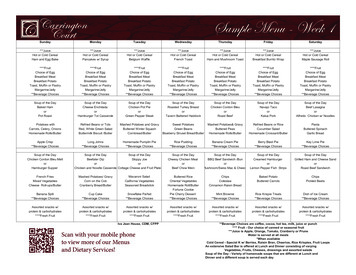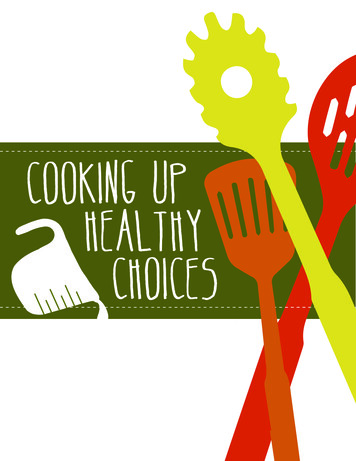
Transcription
HawaiianFood Choices for Healthful Livingbased on food group lists
AcknowledgementsHawaiian Food Choices for Healthy LivingBased on Food Group ListsRevised editionJanuary 2006This edition was made possible with the assistance of Donna Lyn Au, MPH, RD, CancerResearch Center of Hawaii, University of Hawaii; Carrie Blitz, RD, Cancer Research Centerof Hawaii, University of Hawaii; Davelynn Chun, RD, CDE, American Healthways; JoanDobbs, PhD, CNS; Kelley Hatfield, Nutrition Graduate Student, University of Hawaii; RubyHayasaka, MS, MA, RD, Castle Medical Center; Kay Kashiwatani, RD, CDE, St. FrancisMedical Center; Suzanne Murphy, PhD, RD, Cancer Research Center of Hawaii, Universityof Hawaii; Deanna Nakamura, RD, Castle Medical Center; Kourtney Sato, MS, RD, KaiserPermanente Medical Center; Anne Shovic, PhD, RD, University of Hawaii; Stacey Snee,Nutrition Graduate Student, University of Hawaii; Shana Suzuki, Nutrition Graduate Student,University of Hawaii; Amy Tousman, MPH, RD, CDE, Straub Clinic and Hospital; and AileenUeunten, MS, RD, CSR, St. Francis Medical Center.Nutrient analysis sources:Food Processor – Version 7.9 ESHA Research, 2002Cancer Research Center of Hawaii, Food Composition TableThe Food Group Lists are the basis of a meal planning system designed by theAmerican Diabetes Association and The American Dietetic Association.Disclaimer: The use of brand names does not imply endorsement. Nutrient value and exchange listsare based on current data and may be subject to change as new information becomes available.An original publication of the Land GrantInstitutions of the Pacific: AmericanSamoa Community College, College ofMicronesia, Northern Marianas College,University of Guam, and Universityof Hawai‘i, through the AgriculturalDevelopment in the American Pacific (ADAP)Project. Funded through the US Departmentof Agriculture Cooperative Extension Service.March 1994.This manual was originally made possibleby the University of Hawaii ADAP project(Agricultural Development in the AmericanPacific); Kawahine Kamakea Ohelo, Dr.Cecilia Alailima and Teri Hawayeck at theWaimanalo Health Center, Waimanalo,Oahu; Dogma Duffy, Molokai Hospital,Molokai; Trish Britten, Joda Derrickson,Nutrition Specialists, University of HawaiiCooperative Extension Service; and SukFong “Suzette” Lee. Alan Titchenal, Ph.D.,Cover Artist, Honolulu, Hawaii.Revised EditionPrinted January 2006All or part of this publication may bereproduced for educational /hifoodchoices.pdf
Table of ContentsIntroduction. 1Principles of Good Nutrition. 2The Food Groups. 4Nutrient Content by Food Group. 5Meal Planning Using Food Groups. 6Hawaiian Example Menu. 8Meal Plan Form. 9Measuring Your Foods. 10Calcium/Milk Group. 12Starch Group. 13Fruit Group. 15Vegetable Group. 17Protein/Meat Group A (lean). 19Protein/Meat Group B (medium fat). 21Protein/Meat Group C (high in fat). 23Protein/Meat Group D (very high in fat). 24Fat Group A (high in unstaturated fats). 25Fat Group B (high in saturated fats). 26Foods that Do Not Need to be Measured. 27Other Foods for Occasional Use. 28Ethnic Food Dishes. 30Nutrient Value and Food Groups of Plate Lunches. 33Fast Food Restaurants. 34
IntroductionDiet is an important part of the treatment and prevention of manydiseases including obesity, diabetes, heart disease and high bloodpressure. The Hawaiian Food Group Lists have been prepared to helpprovide food composition information so a modified diet can be moreeasily followed.KAUAIOAHUMOLOKAIMAUILANAIHAWAII
Principles of Good Nutrition Maintain a healthy weight.Obesity increases your risk of chronic diseases such as diabetes,hypertension and coronary heart disease. Eat a variety of foods.Eating a variety of foods increases your chance of obtaining all thevitamins, minerals and nutrients your body needs. Eat less fat.Too much fat may cause heart and blood vessel disease. Eat non-friedfish, seafood, poultry, and other lean meats. Watch your portion sizes ofall meat —it's easy to eat too much. Eat fewer foods high in saturated fatsuch as canned luncheon meat, corned beef, coconut milk, gravy, saladdressing, chicken/turkey wings and tails. Eat fewer foods high in transfat commonly found in margarine, shortening, pastries, fried foods, andprocessed snacks. Eat more starches highin fiber.Starches are a good source of energy, vitamins, and minerals. Fiber infoods may help to lower blood-glucose and blood lipid levels. Most allpeople should increase the amount of starches high in fiber. This can bedone by eating more taro, poi, yams, sweet potato, cassava, bananas,breadfruit, dried beans, and peas; more whole grain breads, cereals,and crackers; and more fruit and vegetables.
Eat less sugar.Sugar provides only calories and very little vitamins or minerals. Sugarconsumption also increases the risk of dental cavities. Foods highin added sugar include desserts (such as cakes and pies), sugarybreakfast foods (such as toaster pastries and sugar coated cereals),cookies, candy, pastries, table sugar, honey, sweetened drinks, andsyrup. Eat less salt and sodium.Many of us eat too much salt. The sodium in salt can cause the bodyto retain water, and in some people it may raise blood pressure. Try touse less salt in cooking and at the table. Foods high in sodium, suchas processed and convenience foods, are noted in this booklet with thesymbol “ .” A high source is defined as 560 mg sodium per serving. Limit alcohol intake.It is best to avoid alcohol altogether. If you like to have an alcoholic drinknow and then, ask your physician or nutritionist about working it intoyour meal plan. Potassium.Foods high in potassium are recommended as part of a healthy eatingregime for most people. Some people, especially those on kidneydialysis, may have to limit their potassium intake. A high source ofpotassium is defined as more than 300 mg potassium per serving and isnoted in this booklet with the symbol “b.”
The Food GroupsTo make it easier for you to follow your meal plan and to meet yournutritional needs, foods have been divided into six Food Groups.The reason for dividing food into six different groups is that foods vary intheir carbohydrate, protein, fat, and calorie content. Each group containsfoods that are alike and contain about the same amount of carbohydrate, protein, fat, and calories. The chart on the following page showsthe amount of these nutrients in one serving from each Food Group.As you read over the Food Group Lists, you will notice that the portionsize may vary. Because foods are so different, serving size for each foodis adjusted so the amount of carbohydrate, protein, fat, and calories aresimilar for each choice.If you have a favorite food that is not included in any of these groups,ask your nutritionist to help work it into your meal plan.
Nutrient Content by Food GroupFood GroupCarbohydrate ace80Protein/MeatA–Very /MilkSkimReduced ble
Meal Planning Using Food GroupsYour Meal Plan should include foods from each Food Group. The number of foods in each group is planned toprovide you with a balanced diet to fit your needs.Calcium/Milk GroupThe Calcium/Milk Group includes milk and milk products. These foodscontain calories, protein, calcium, phosphorus, vitamin A and several Bvitamins.Vegetable GroupThe Vegetable Group includes some vegetables high in potassium,vitamin A, vitamin C and fiber which are important to health. Highvitamin A sources (over 333 RE per serving) will be indicated with a“ ” symbol, high vitamin C sources (over 30 mg per serving) will beindicated with a “ ” symbol and high potassium sources will be indicatedwith a “b” symbol in this booklet.Fruit GroupThe Fruit Group includes all kinds of fruit. Some fruits are excellentsources of vitamin C and potassium. Orange colored fruits, such asmango and papaya, also contain vitamin A.Starch GroupThe Starch Group includes foods that provide carbohydrates in the formof starch. Whole grain cereals, rice, noodles, dried beans and peas, andstarchy vegetables (such as taro, breadfruit, and sweet potatoes) aregood sources of many B vitamins, and potassium. Whole grains are alsohigh in fiber.
Protein/Meat GroupThe Protein/Meat Group includes foods which provide protein, somefat, minerals and vitamins and varying levels of fat. This group includesmeats, fish, poultry, eggs, tofu, and cheese.The kind of meat or other protein foods makes a difference. The Protein/Meat Group has been divided into four lists: very lean, lean, medium andhigh fat Protein/Meat Groups.Most meats you eat should be lean since fat contributes twice as manycalories as protein or carbohydrate. Cut off all visible fat before cooking.Bake, broil, roast, stew or pan-fry without added fat. Discard the fat thatcomes out of the meat while cooking.Fat GroupThe Fat Group includes foods high in fats. There are several categoriesof fats, notably: 1) Saturated Fats such as fats from animals andcoconut palm oils; 2) Unsaturated Fats (polyunsaturated andmonosaturated) are liquid vegetable oils and 3) Trans Fats commonlyfound in margarine, shortening, pastries, snack foods, and fried foods.Your doctor may want you to be on a "Fat Controlled" diet. This meansthat you control the kind of fat you use as well as the amount.
Example Hawaiian MenuThe following sample menus are provided to show you how to use your Meal Plan. The fat content providesapproximately 25% of the total calorie intake. The protein content is 15–20% and carbohydrate content about50% of total calories. These sample menus are planned to meet the nutritional needs of adults and are notmeant to be used for children.Sample Menu (1600 calories)Daily Servings:Calcium/Milk2Vegetables3Fruit4Breakfast1 Fruit2 Starch1 Calcium/Milk1 Fat1/2 papaya2 slices whole grain toast1 cup skim milk1 teaspoon margarineLunch2 Protein/Meat B2 Starch1 Vegetable1 Fat1 Fruit2 ounces lean pork2 slices whole grain bread1/2 cup eggplant1 teaspoon mayonnaise1/2 cup mangoSnack1 Starch3 soda crackers1 Protein/Meat C 1 level tablespoon peanut butterStarch8Protein/Meat A2Dinner2 Protein/Meat A2 Vegetable1 Fat1 Fruit1 Calcium/Milk(add 1 Fat)3 StarchSnack1 FruitProtein/Meat B2Protein/Meat C1Fat4Stirfry: 2 ounces skinlesschicken breast1/2 cup green pepper1/2/ cup cooked green leaves1 teaspoon margarine3/4 cup fresh pineapple1/2 cup tofu made with calcium1 cup cooked rice1 cup cantaloupe
Meal Plan FormYou may want to divide your food for the day this way:Meal PlanNumber of ServingsFoodAmountBreakfast:Fruit Group Protein/Meat Group (A, B, C, or D)Starch GroupFat GroupCalcium/Milk GroupCoffee or tea, plainLunch:Protein/Meat GroupStarch GroupVegetable GroupFat GroupFruit GroupCalcium/Milk GroupCoffee or tea, plainDinner:Protein/Meat GroupStarch GroupVegetable GroupFat GroupFruit GroupCoffee or tea, plainSnack:Protein/Meat GroupStarch GroupFat GroupCalcium/Milk Group
Measuring Your FoodsMeasuring is a key to knowing how much food you eat. Themeasurement in ounces, inches, spoons, or cups is indicated for eachfood in the Food Groups.You need a set of measuring cups which includes a full 8-ounce cup, ahalf cup, a third of a cup and a quarter cup. You also need a teaspoon, atablespoon, and a ruler to measure your meats.All measurements in this book are level. Do not heap or pack your cupsor bowls. For example, to measure a level spoonful, fill your spoon,then run a knife edge across the spoon pushing off all the extra food.Measuring a level cupful would involve the same process.Heaping SpoonfulHEAPING SPOONFULA small food scale is also very helpful especially for measuring meats.Make sure the scale measures ounces accurately.Foods which are eaten cooked should be measured after they arecooked. Any fat that is used in cooking must be counted as part of a fatgroup. Frying adds a great deal of fat. For example, a breast of chickenwhich has been rolled in flour and fried may add 1 starch group and 2 ormore fat groups.Measure your foods until you can train your eye to be accurate. Checkall your measurements every once in a while to be sure you are correct.You may want to measure your usual bowls and plates so you do nothave to measure all the time.Leveling SpoonfulLEVELING SPOONFULLevel SpoonfulLEVEL SPOONFUL10
A golf ball, tennis ball, yo-yo, computer mouse, baseball, fist, and a deck of playing cards make convenientguides to judge moderate portions of food. 2 Tablespoon measure2 Tablespoon salad dressing,peanut butter, margarine, etc.Large fruit (or 1 cup volume)Apple or orangeGolf BallBaseball Ball Medium/small fruit1/2 cup measure1 cupReady-to-eat breakfast cerealWoman's Fist 1 English muffin1 English muffin 2 breadservingsYo-Yo A 3 ounce measureModerate portion of meatA Tennis BallDeck of Cards1/2 to 3/4 cupBaked potato; ground or choppedfoods; 1/2 cup 2 oz.Computer Mouse11
Calcium/Milk GroupOne nonfat calcium/milk serving contains approximately 90 calories, 12 grams carbohydrates, 8 grams proteinand a trace of fat. (For those who watch potassium intake, limit milk product servings. A cup of milk containsover 300 mg potassium).FoodNonfat MilkSkim milk or 1% milkNonfat dry milk powderEvaporated skim milkYogurt prepared with skim milk, unflavoredReduced Fat Milk (add 1 fat for each)Low fat soy milk (unsweetened)Low fat buttermilk2% milkEvaporated 2% milkYogurt prepared with low fat or 2% milk,unflavoredYogurt prepared with 2% milk, flavored(add 1 fruit)Yogurt, light, with artificial sweetenerprepared with 1% milkYoplait, regular (add 1 fruit)Yoplait, lightWhole milk (add 2 fat groups)Whole milkEvaporated milkYogurt prepared with whole milk, unflavoredYogurt prepared with whole milk, with fruit(add 1 fruit)Measure1 cup1/3 cup1/2 cup3/4 cup (6 oz.)1 cup1 cup1 cup1/2 cup1 Cup Skim Milk3/4 cup (6 oz.)3/4 cup (6 oz.)1 cup3/4 cup (6 oz.)3/4 cup (6 oz.)1 cup1/2 cup1 cup1 cup1/3 Cup Nonfat DryMilk Powder1/2 Cup Evaporated MilkAdd 2 Fat ExchangesNote: There are many calcium fortified products on the market forthose that do not eat dairy products. Check the labels. A good sourcecontains 300 mg or more calcium per serving.12
Starch GroupOne starch serving contains approximately 80 calories, 15 grams of carbohydrate and 3 grams of protein.FoodMeasureBreadsBagelBiscuitBread (white, whole wheat, rye,raisin, French)Bread crumbsBun, hamburgerBun, hot dogCornbread (add 1 fat)English muffinMuffin, plain, small (add 1 fat)NoodlesPancake (add 1 fat)PitaPretzelsRice cakeRoll, plainStuffing (add 1 fat)Taco shell (add 1 fat)Tortilla (unfried)Waffle (add 1 fat)1/2 (3" diameter)or 1 ounce1 (2" diameter)1 slice3 tablespoons1/2 bun (4" diameter)1/2 bun1 (2" x 2" x 1")1/21 ounce1/3 cup1 (4" diameter)1 (6" diameter)3/4 ounce2 (4" diameter)1 (2" diameter)1/4 cup2 hard shells1/2 (8" diameter)1 (4-1/2" diameter)FoodMeasureCerealsbAll cooked1/2 cupbBran Flakes, All Bran, Raisin Bran 1/2 cupbBran (coarse texture)1/2 cupbCornmeal, dry1/3 cupbDry, puffed or flaked (not sugared) 3/4 cupbGranola1/4 cupbGrape Nuts1/4 cupbShredded wheat1/2 cupbWheat germ3 tablespoonsCoconutbImmature meat (sponge) (add 1 fat)1-3/4 cupsbCoconut water2 cupsCrackersbCreme PilotbGrahambMelba toastbMochi CrunchbRitz, plainbRy Krisp, double square waferbSaloon pilotbSaltinesbSodabWheat Thins1-1/23 (2-1/2" square)4 (3-3/4" x 2")1/3 cup4316 (2" square)3 (2-1/2" square)7 Good source of vitamin C Good source of vitamin A Food high in saltbFood high in potassium13
Starch GroupFoodFlour Products Cornstarch Flour, all kinds Noodles, cellophane Noodles; macaroni, spaghetti Buckwheat noodles Won ton wrapper, 7" square Ramen, dry (add 2 fat) Ramen, fresh, frozen (0 fat)RiceSoup Long rice, cooked Mochi Rice, cookedBrownInstantWhite, enriched Noodle/rice base Cream base (add 1 fat)(Continued)Measure2 tablespoons2 tablespoons3/4 cup1/3 cup cooked1/3 cup cooked11/2 block (1-1/2 oz. dry)1/2 cup cooked1/2 cup1 (2" x-1/2")1/3 cup1/3 cup1/3 cup1 cup1 cupStarchy Vegetables — Raw or CookedbArrowroot2 ouncesbArtichoke1 wholebBeans and peas; dried, cooked1/3 cupbBurdock (gobo)1/2 cupbBreadfruit, cooked1/3 cupFoodMeasureStarchy Vegetables (Continued) bCassava1/3 cup bCorn1/2 cup bCorn on the cob1 (6" long) bLima beans1/2 cup bLotus root3/4 cup bParsnips2/3 cup bPeas, green1/2 cup bPidgeon peas, pods1/2 cup bPlantain (green banana)1/2 medium or 1/2 cup bPoi from taro or breadfruit, 2 finger 1/2 cup bPopcorn (without butter)3 cups bPotatoesWhite, whole1 (“ diameter)White, mashed, plain1/2 cupb Sweet potato or yams1/2 cupb Pumpkin3/4 cup bSoybeans, green1/2 cupb Squash, winter, yellow3/4 cup bTaro (cooked)1/2 cup (or-1/2" slice) Good source of vitamin C Good source of vitamin A Food high in saltbFood high in potassium14
Fruit GroupOne fruit serving contains approximately 60 calories and 15 grams of carbohydrate. These fruit may be fresh,cooked, dried, or frozen without sugar.FoodMeasure Apple, fresh b Apple, mountain b Applesauce bApple juice bApricots, fresh bApricots, dried bApricots, canned & drained1/2 medium or 1 small(2" diameter)2 medium1/2 cup1/2 cup4 medium4 halves4 halves bBanana bBanana, dried bBlueberries1/2 medium or 1/2 cup or 4"3 tablespoons3/4 cup bCantalope bCherries, fresh bCherries, canned & drained bCranberry juice cocktail1 cup12 pieces1/2 cup1/4 cup bDates2-1/2 fruits bFigs, fresh bFigs, canned & drained bFruit cocktail & drained bFruit, dried2 medium, 2" each21/2 cup2 tablespoons bGrapes, fresh bGrape juice10 large grapes or 15 smallFoodMeasureb Grapefruit, freshb Grapefruit, canned & drainedb Grapefruit, juice bGuava, fresh1/2 medium (3-1/2" diameter)3/4 cup1/2 cup1 medium (2-1/2" diameter) bHoneydew melon1 cup bbJack fruit b Juice (fruit)1/3 cup1/2 cup bKiwi bKumquat1 large, 1/2 cup5 fruits b Lychee10 fruits or 1/2 cup b Mandarin orange bMango, ripe bMango, green3/4 cup1/2 cup or 1/2 small3/4 cup bNectarine1 (1-1/2" diameter) bOhelo berries bOrange, fresh bOrange juice1-1/2 cups1/2 large or 1 small1/2 cup Good source of vitamin C Good source of vitamin A Food high in saltbFood high in potassium15
Fruit GroupFood bPapaya bPassion fruit juice bPeach, fresh bPeach, canned & drained bPear, fresh bPear, dried bPear, canned & drained bPersimmon, Japanese bPersimmon, native b Pineapple, fresh, b Pineapple, canned in own juice b Pineapple juice bPlums, fresh bPlums, canned & drained b Poha berries bPomegranate bPomelo (Jabon) bPrunes, dried bPrune juice(Continued)Measure1/2 medium or 1 cup cubed1/2 cup1 medium1/2 cup or 2 halves1/2 large or 1 small12 small halves or 1/2 cup1/2 medium2 fruits3/4 cup3/4 cup1/2 cup2 medium41 cup1/2 medium1 cup sections3 medium1/3 cupFoodMeasure Raisins2 tablespoons bSoursop, pulp Starfruit Strawberries Sweetsop1/3 cup1-1/2 cups1-1/4 cups1/2 of a 3" fruit Tangerine2 medium Watermelon1-1/4 cup cubed Good source of vitamin C Good source of vitamin A Food high in saltbFood high in potassium16
Vegetable GroupOne vegetable serving contains about 25 calories, 5 grams of carbohydrate and 2 grams of protein.One exchange is 1/2 cup cooked or 1 cup raw. bAloe vera juice Asparagus Kale bKohlrabi Bamboo shoot Bean sprouts, mung bBeans, goa (winged) Beans, green Beets Beet greens bBittermelon, fruit Broccoli Brussel sprouts Leeks Carrots Cauliflower Chayote, fruit Chayote, leaves Collards Cucumber Dandelion greens Eggplant bFernshoots (warabi) bGourd, dish cloth Gourd, dried (1 strip) Gourd, white flowered Green beans Mushroomsb Vegetable juice b Water chestnuts b Zucchini Okra Onion, round bPapaya green Pea pods Pepper, green, red, yellow, or bell Pumpkin leaves bPurslane Rutabaga bSpinach Squash, leaves bSweet potato leaves/shoots Swiss chard bTaro leaves bTomato, canned or fresh bTomato juice bTomato paste Turnip Turnip greens Good source of vitamin C Good source of vitamin A Food high in saltbFood high in potassium17
Vegetable Group(Continued)These may be eaten raw as desiredor up to one cup cooked.bBanana blossom Bok choybCabbage - all kindsbCelery Green OnionsbKombu seaweed Kon yaku LettucebSeaweed Sprouts Radishes (includes daikon) Turnip leaves Ume (plum) Watercress Good source of vitamin C Good source of vitamin A Food high in saltbFood high in potassium18
Protein/Meat Group A (very lean)The protein/meat groups have been divided into four groups according to the fat content.Protein/Meat Group A (very lean). One protein/meat serving contains approximately 35 calories,7 grams protein, and 0-1 grams fat.FoodMeasure Cheese Fat free1 ounce or 1" cube Chicken (skin removed)Breast1 oz. or 1 piece (3" x 3" x 1/4") EggEgg substituteEgg whites, large Pork Blood SeafoodAbalone, canned and drainedBigeye (Aweoweo), cookedBlue Fish or Croaker; cookedBonito (Kawakawa); cookedGoat Fish (Weke, Dama,Moano, Kumu), cookedHalibut, cookedJack Fish, Amber: cookedJack Fish, Blue Runner; cookedJack Fish, Trevally; cookedLobsterMahi Mahi (Dolphinfish); cookedMilk Fish, cooked; cookedParrot Fish (Uhu); cooked1/4 cup21/4 cup1 ounce1 ounce1 ounce1 ounce1 ounce1 ounce1 ounce1 ounce1 ounce1 ounce1 ounce1 ounce1 ounce Good source of vitamin C Good source of vitamin A Food high in saltbFood high in potassium19
Protein/Meat Group A (very lean)Food(continued)Measure Seafood (Continued)Pollock; cookedRock Fish; cookedScad, bigeyed (Akule, Halalu, Aji); cookedSquirrel Fish, Red (Menpachi, Uu); cookedSurgeon Fish (Kala, Kole, Palani); cookedTilapia; cookedTuna, canned in waterTuna (Ahi), cookedTuna, Bluefin (Maguro); cookedTuna, Skipjack (Aku, Katsuo); cookedYellowtail, Japanese (Hamachi); cooked1 ounce1 ounce1 ounce1 ounce1 ounce1 ounce1 ounce1 ounce1 ounce1 ounce1 ouncebTofu, okara1/2 cup TurkeyBreast (skin removed)1 oz. or 1 piece (3" x 3" x 1/4") Good source of vitamin C Good source of vitamin A Food high in saltbFood high in potassium20
Protein/Meat Group B (lean)The protein/meat groups have been divided into three groups according to the fat content.Protein/Meat Group A (lean). One protein/meat serving contains approximately 55 calories, 7 grams protein,and 3 grams fat.FoodMeasure JerkyLean chuckFlank steakGround beef (less than 10% fat)Porterhouse steakT-bone steakSirloin steakTenderloin steakRound steakRump steak3/4 ounce 1 ounce or 1 piece (3" x 2" x 1/4")1 ounce or 1 piece (3" x 2" x 1/4")1 ounce1 ounce or 1 piece (3" x 2" x 1/4")1 ounce or 1 piece (3" x 2" x 1/4")1 ounce or 1 piece (3" x 2" x 1/4")1 ounce or 1 piece (3" x 2" x 1/4")1 ounce or 1 piece (3" x 2" x 1/4")1 ounce or 1 piece (3" x 2" x 1/4")BeefCheeseContaining less than 5% fatCottage, dry or 2% butterfatParmesanFarmersRicottaChicken (skin removed, cooked)DrumstickThighRoasted meat1 ounce or 1" cube1/4 cup2 tablespoons1 ounce or 1" cube1 ounce or 1" cube1 ounce1/2 piece (4 pieces to one pound)1 ounce or piece (3" x 3" x 1/4")Note: The Calcium/Milk group is included when cheese is consumed. Good source of vitamin C Good source of vitamin A Food high in saltbFood high in potassium21
Protein/Meat Group B (lean)Food(Continued)MeasurebLiver or heart1 ouncebNatto (fermented soybean)1 ouncebPork Lean leg1 ounce or 1 piece (3" x 3" x 1/4")bSeafood Catfish Opelu, steamed Mackerel, cooked Wahoo (Ono); cooked Fish cake paste Salmon, canned, drained Sardines, canned in oil, drained Tuna, canned in oil, drained1 ounce1 ounce1 ounce1 ounce1/4 cup1/4 cup2 ounces1 ouncebTofu1/2 ouncebTurkey (skin removed) Dark meat, roasted Turkey ham, turkey pastrami1 ounce1 ounce1 ounce or 1 piece (3" x 3" x 1/4")bVeal Chop or roast1 ounce or 1 piece (3" x 2" x 1/4") Good source of vitamin C Good source of vitamin A Food high in saltbFood high in potassium22
Protein/Meat Group C (medium fat)Protein/Meat Group C (medium fat). One protein/meat serving contains approximately 75 calories, 7 gramsprotein, and 5 grams fat.FoodMeasureBeef Corned beef Ground beef (20% fat) Rib eye1 ounce or 1 piece (3" x 2" x 1/4")1 ounce1 ounce or 1 piece (3" x 2" x 1/4")Cheese Cottage, creamedMozzarella, Ricotta, Farmers, Gouda,Neufchatel1/4 cupChicken Wing with skin1 wing (6 pieces to one pound)Dog1 ounceDuck, Goose (skin and fat removed)1 ounceEgg, whole, chicken or duck1 largeFish Shad, American; cooked1 ounceLamb Lean leg, loin, rib, shank, shoulder, sirloin1 ounce or 1 piece (3" x 2" x 1/4")Pork Boiled ham, butt, loin, shoulder, arm, picnic Shoulder blade, Canadian bacon1 ounce or 1 piece (3" x 2" x 1/4")1 ounce or 1 piece (3" x 2" x 1/4")Sweetbreads (brains, gizzards)1 ounceTurkey, ground (20% fat)1 ounce1 ounce or 1" cube Good source of vitamin C Good source of vitamin A Food high in saltbFood high in potassium23
Protein/Meat Group D (high in fat)Protein/Meat Group D (high in fat). One protein/meat serving contains approximately 100 calories, 7 gramsprotein, and 8 grams fat.FoodMeasure Beef BrisketGround beef (30% or more fat)Lean short ribsRib roast, club and rib steakSpare ribs (meat, without bone)1 ounce1 ounce1 ounce1 ounce or 1 piece (3" x 2" x 1/4")1 ounce Cheese Cheddar, American, Monterey,Swiss, Provolone, Blue1 ounce or 1" cube Cold cuts1 ounce Frankfurter1 (10 per pound) Lamb1 ounce or 1 piece (3" x 2" x 1/4") Peanut butter1 tablespoon Pork Spareribs, loins (back ribs), ground pork, country style ham, pork belly1 ounce or 1 slice (3" x 2" x 1/4") Sausage Lup chong, Portugese, Vienna1 ounce, link or patty Spam (canned luncheon meat)1 ounce or 1 slice (3" x 2" x 1/4") Tofu, extra firm1/2 cup Turkey tail1/2 ounce Wings ChickenTurkey11/2 Good source of vitamin C Good source of vitamin A Food high in saltbFood high in potassium24
Fat Group A (high in unsaturated fats)The fat group have been divided into two sections, those which are high in unsaturated fats and those whichare high in saturated fat.Fat Group A - high in unsaturated fats. One fat serving contains approximately 45 calories and 5 grams of fat.FoodMeasureAvocado1/8 of 4" diameterDressings, Salad All varietiesReduced calorieMayonnaiseMayonnaise, reduced calorieMiso1 tablespoon2 tablespoons1 teaspoon1 tablespoon1 tablespoonMargarine (first ingredient, liquid oil)1 teaspoonNuts tsOther nuts1 tablespoon (6 nuts)1 tablespoon (6 nuts)1 tablespoon (6 nuts)1 tablespoon (10 nuts)1 tablespoon (4 halves)1 tablespoon (6 nuts)1 tablespoon (4 halves)1 tablespoonOilcottonseed, corn safflower, sesame,soybean and sunflowerOIL1 teaspoonOlives, ripe10 small or 5 largePeanut butter1/2 tablespoonPeanut dipping sauce (Thai style)1-1/2 tablespoonsSesame seeds1 tablespoonSunflower seeds, unshelledshelled1/4 cup1 tablespoonTartar sauce2 teaspoons Good source of vitamin C Good source of vitamin A Food high in saltbFood high in potassium25
Fat Group B (high in saturated fats)Fat Group A - high in saturated fats. One fat serving contains approximately 45 calories and 5 grams of fat.FoodMeasure Butter1 teaspoon Bacon, crisp1 slice Cheese, cream1 tablespoon Coconut bImmature meat (sponge)bMature meatbCream, no water addedbMilk (1 cup water to 1 cup cream)bCoconut, grated1-3/4 cup (add 1 bread)1 piece (1" x 1" x 3/8")1 tablespoon2 tablespoons1-1/2 tablespoons Cream Coffee creamSour creamWhipping, heavy, liquid2 tablespoons2 tablespoons1 tablespoon Margarine (first ingredient hydrogenated orhardened oil)1 teaspoon Non-dairy creamer LiquidPowder2 tablespoons1-1/2 tablespoons Salt pork1/4 oz. Solid cooking fats (including lard, shortening)1 teaspoon Sour cream2 tablespoons Good source of vitamin C Good source of vitamin A Food high in saltbFood high in potassium26
Foods that Do Not Need to be MeasuredSome foods and condiments have very little carbohydrate, protein or fat and can be used without measuringand with a few exceptions, as often as you like unless you are on a sodium restricted diet.BeveragesCarbonated water, club sodaCoffee, plainSoft drinks, artifically sweetenedSugar free drink mixesTeaWaterDessertsGelatin desserts,artificially sweetenedSugar substitutesSoups Bouillon, without fat Clear brothSeasonings Chives Fish sauce Furikake Garlic Ginger, raw or pickled Mustard, dry or prepared Nori Parsley Pepper Pickled melon (narazuke) Pickled scallions (rakkyo, rankyo) Salt (in moderation) Soy Sauce (in moderation) Spices and her
cookies, candy, pastries, table sugar, honey, sweetened drinks, and syrup. Many of us eat too much salt. The sodium in salt can cause the body to retain water, and in some people it may raise blood pressure. Try to use less salt in cooking and at the table. Foods high in sodium, such











